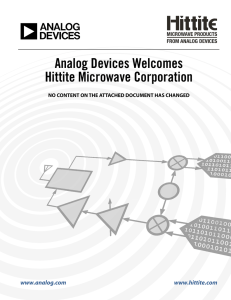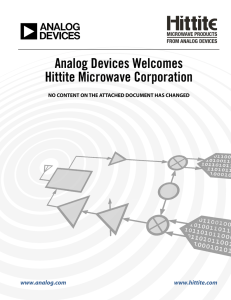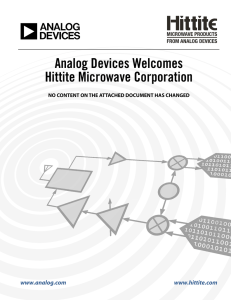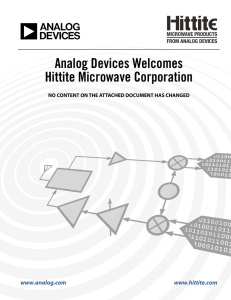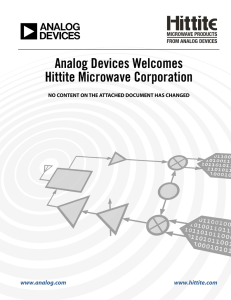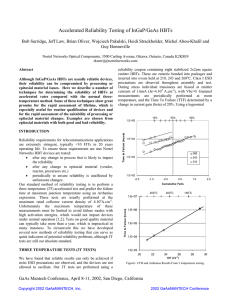Analog Devices Welcomes Hittite Microwave Corporation www.analog.com www.hittite.com
advertisement
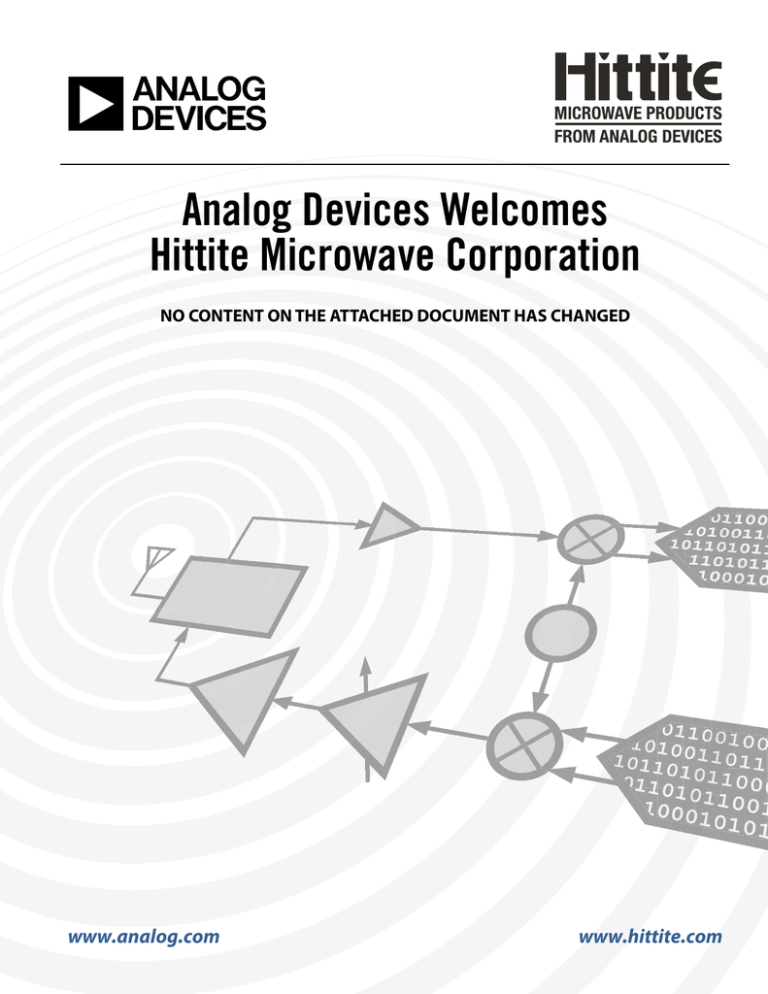
Analog Devices Welcomes Hittite Microwave Corporation NO CONTENT ON THE ATTACHED DOCUMENT HAS CHANGED www.analog.com www.hittite.com Report Title: Qualification Test Report Report Type: See Attached Date: See Attached QTR: 2013- 00252 Wafer Process: GaAs HBT-D HMC755 HMC881 HMC882 HMC890 HMC892 HMC921 Rev: 02 QTR: 2013- 00252 Wafer Process: GaAs HBT-D Rev: 02 Introduction The testing performed for this report is designed to accelerate the predominant failure mode, electro-migration (EM), for the devices under test. The devices are stressed at high temperature and DC biased to simulate a lifetime of use at typical operating temperatures. Using the Arrhenius equation, the acceleration factor (AF) is calculated for the stress testing based on the stress temperature and the typical use operating temperature. This report is intended to summarize all of the High Temperature Operating Life Test (HTOL) data for the GaAs HBT-D process. The FIT/MTTF data contained in this report includes all the stress testing performed on this process to date and will be updated periodically as additional data becomes available. Data sheets for the tested devices can be found at www.hittite.com. Glossary of Terms & Definitions: 1. CDM: Charged Device Model. A specified ESD testing circuit characterizing an event that occurs when a device acquires charge through some triboelectric (frictional) or electrostatic induction processes and then abruptly touches a grounded object or surface. This test was performed in accordance with JEDEC 22-C101. 2. ESD: Electro-Static Discharge. A sudden transfer of electrostatic charge between bodies or surfaces at different electrostatic potentials. 3. HBM: Human Body Model. A specified ESD testing circuit characterizing an event that occurs when a device is subjected to an electro-static charge stored in the human body and discharged through handling of the electronic device. This test was performed in accordance with JEDEC 22-A114. 4. HTOL: High Temperature Operating Life. This test is used to determine the effects of bias conditions and temperature on semiconductor devices over time. It simulates the devices’ operating condition in an accelerated way, through high temperature and/or bias voltage, and is primarily for device qualification and reliability monitoring. This test was performed in accordance with JEDEC JESD22-A108. 5. HTSL: High Temperature Storage Life. Devices are subjected to 1000 hours at 150oC per JESD22-A103. 6. MSL: Moisture sensitivity level pre-conditioning is performed per JESD22-A113. 7. Operating Junction Temp (Toj): Temperature of the die active circuitry during typical operation. 8. Stress Junction Temp (Tsj): Temperature of the die active circuitry during stress testing. 9. Temperature Cycle: Devices are subjected to 500 cycles of -65°C to 150°C. This test is performed in accordance with JESD22-A104. QTR: 2013- 00252 Wafer Process: GaAs HBT-D Rev: 02 10. UHAST: Unbiased Highly Accelerated Stress Test. Devices are subjected to 96 hours of 85% relative humidity at a temperature of 130°C and pressure (18.6 PSIG). This test is performed in accordance with JESD22-A118. Qualification Sample Selection: All qualification devices used were manufactured and tested on standard production processes and met pre-stress acceptance test requirements. Summary of Qualification Tests: HMC890 (QTR2013-00020) TEST QTY IN QTY OUT PASS / FAIL Initial Electrical 933 933 Complete HTOL, 1000 hours 80 80 Complete Post HTOL Electrical Test 80 80 Pass MSL3 Preconditioning 160 160 Complete MSL3 Preconditioning Final Test 160 160 Pass UHAST (Preconditioned) 80 80 Complete UHAST Final Test 80 80 Pass Temperature Cycle (Preconditioned) 80 80 Complete Temperature Cycle Final Test 80 80 Pass ESD 36 36 Complete NOTES HBM Class 1A CDM Class IV MM 150V QTR: 2013- 00252 Wafer Process: GaAs HBT-D Rev: 02 GaAs HBT-D Failure Rate Estimate Based on the HTOL test results, a failure rate estimation was determined using the following parameters: With device ambient case temp, Tc = 85°C HMC890 (QTR2013-00020) Operating Junction Temp (Toj) =85°C(358 °K) Stress Junction Temp (Tsj) = 150 °C(423 °K) Device hours: HMC890 (QTR2013-00020) = (80 X 1000hrs) = 80,000 hours For GaAs HBT-D MMIC, Activation Energy = 1.36 eV Acceleration Factor (AF): HMC890 (QTR2013-00020) Acceleration Factor = exp[1.36/8.6 e-5(1/358-1/423)] = 887.0 Equivalent hours = Device hours x Acceleration Factor Equivalent hours = (80,000x887) = 7.10x107 hours QTR: 2013- 00252 Wafer Process: GaAs HBT-D Rev: 02 Since there were no failures and we used a time terminated test, F=0, and R = 2F+2 = 2 The failure rate was calculated using Chi Square Statistic: at 60% and 90% Confidence Level (CL), with 0 units out of spec and a 85°C package backside temp; Failure Rate 60 = [(2)60,2]/(2X 7.10x107 )] = 1.8/ 1.42x108 = 1.29x10-8 failures/hour or 13 FIT or MTTF = 7.76x107 Hours 90 = [(2)90,2]/(2X 7.10x107 )] = 4.6/ 1.42x108 = 3.25x10-8 failures/hour or 32 FIT or MTTF = 3.08x107 Hours
